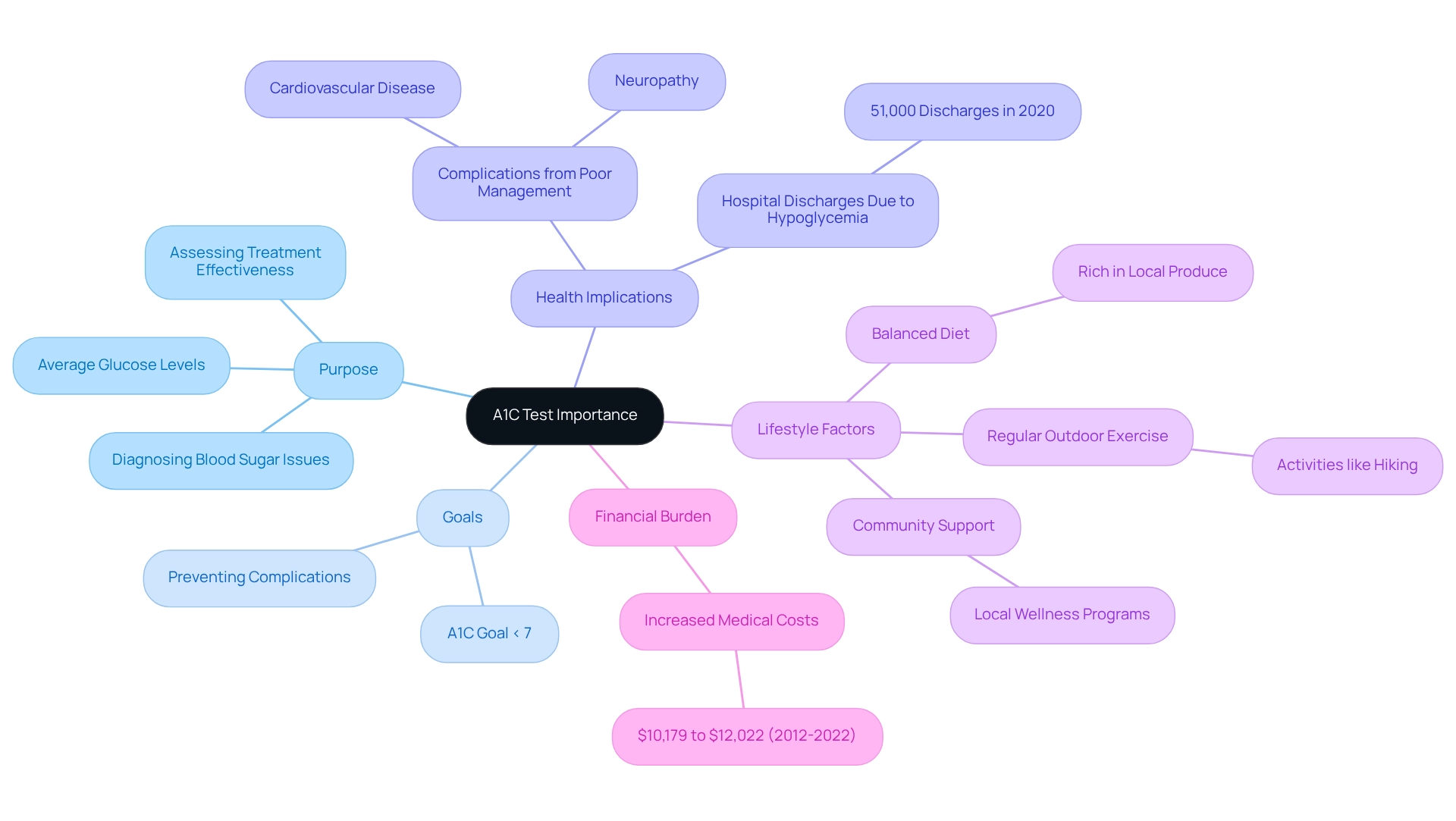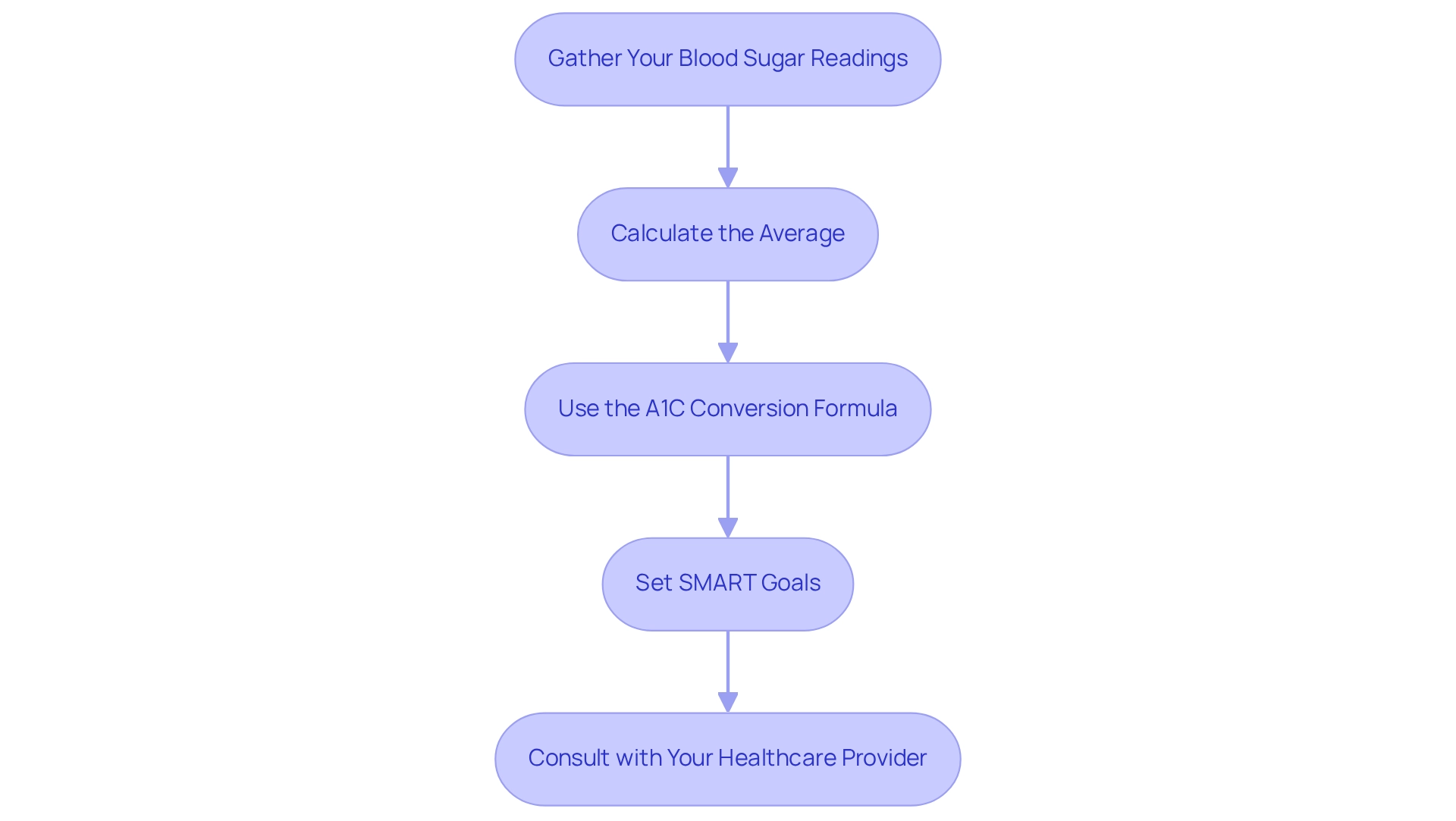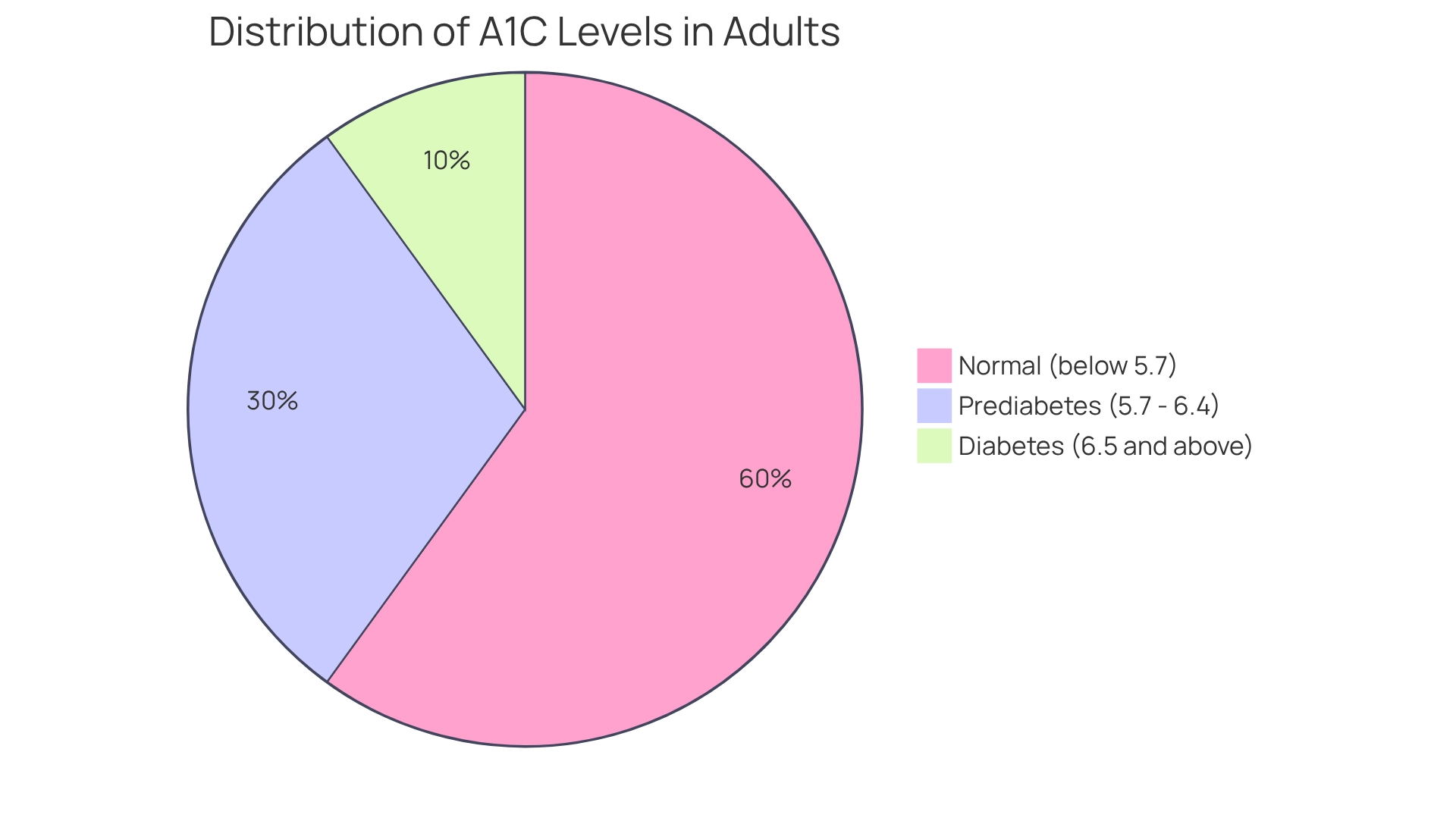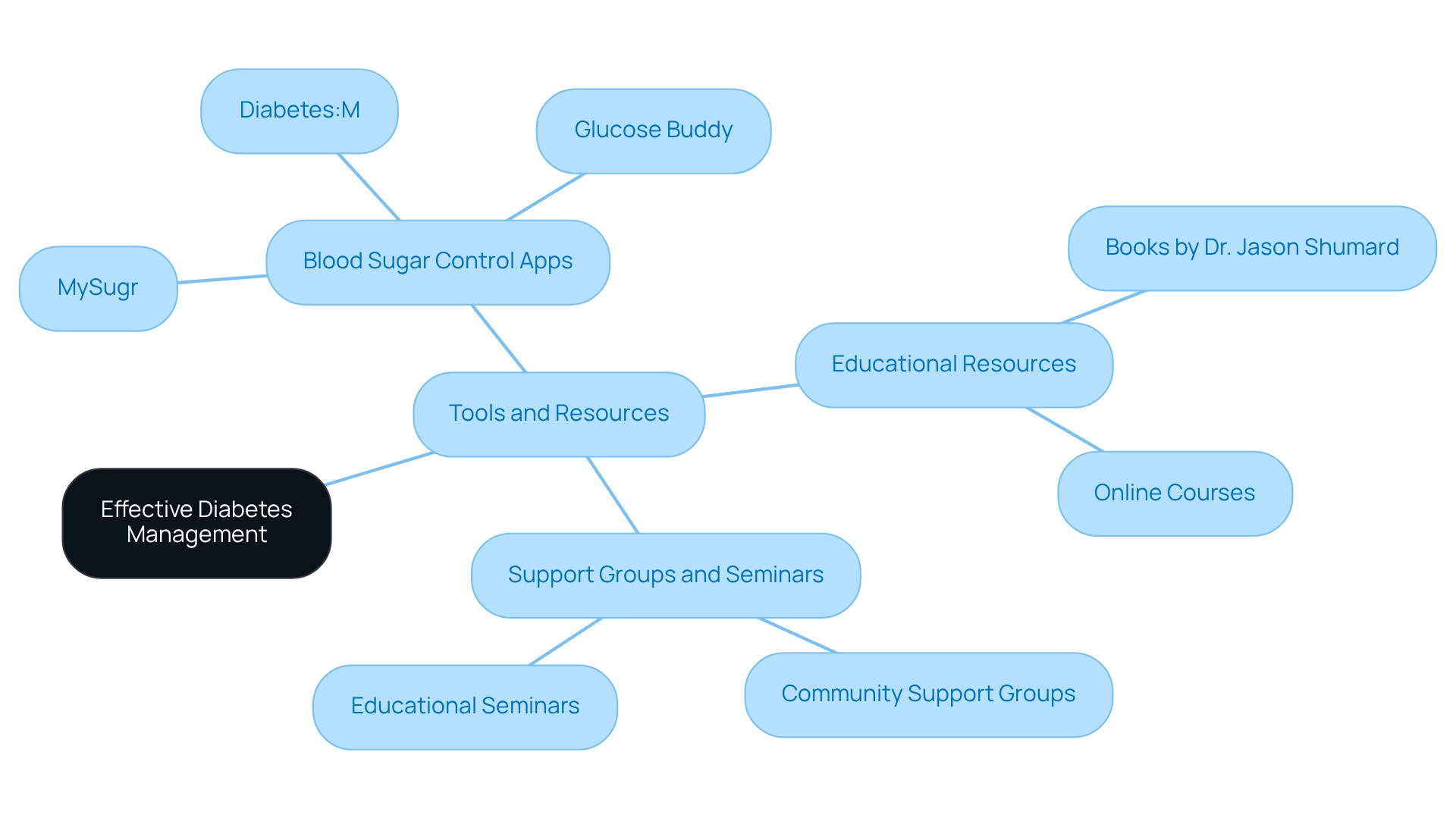Overview
This article offers a caring, step-by-step guide for calculating A1C, a vital aspect of managing diabetes and monitoring long-term blood sugar levels.
It’s important to recognize that regular A1C testing can significantly impact your health. By making lifestyle modifications, as supported by data and case studies, many individuals find they can maintain their A1C below 7%. This not only helps in managing diabetes but also reduces the risk of complications.
Remember, you’re not alone in this journey; there are ways to navigate these challenges together.
Introduction
In the journey of managing diabetes, understanding the A1C test is essential for those striving to achieve their best health. This important assessment not only helps in diagnosing diabetes and prediabetes but also acts as a vital indicator for tracking long-term blood sugar control.
Many patients find that aiming for an A1C goal of less than 7%, as recommended by the American Diabetes Association, can significantly impact their lifestyle choices and treatment plans.
It’s important to recognize that as diabetes rates continue to rise, the need for integrating holistic strategies—like balanced nutrition and community support—into management plans is more critical than ever.
This article explores the intricacies of the A1C test, offering insights on its calculation, interpretation, and effective resources to empower you on your path to reclaiming your health.
Understand the A1C Test and Its Importance
The A1C test, or hemoglobin A1C test, is an essential tool in blood sugar management, particularly in calculating A1C by measuring average glucose levels over the past two to three months. It’s expressed as a percentage, reflecting the proportion of hemoglobin molecules in the blood that have glucose attached. This test plays a crucial role not only in diagnosing blood sugar issues and prediabetes but also in assessing how effective treatment plans are.
Regular testing of A1C, particularly calculating A1C levels, empowers individuals to monitor their long-term blood sugar management, which is vital for preventing complications related to glucose disorders, such as cardiovascular disease and neuropathy. It’s important to recognize that in 2025, the American Diabetes Association continues to recommend an A1C goal of less than 7% for most adults with these conditions. This target significantly lowers health risks.
Many patients find that recent studies highlight the efficacy of calculating A1C for controlling blood sugar. Those who maintain their A1C readings within this range tend to encounter fewer complications. For instance, a significant case study emphasized how understanding the elements influencing A1C accuracy, particularly calculating A1C, can lead to improved strategies, ensuring that patients and healthcare providers interpret results accurately.
Incorporating comprehensive lifestyle approaches, such as:
- A balanced diet rich in local produce
- Regular outdoor exercise
- Community support
can profoundly influence A1C levels. Engaging in activities like hiking or participating in local wellness programs not only enhances physical health but also fosters a supportive environment for managing blood sugar levels.
Statistics show the urgent need for effective control of the condition, with additional medical expenses per individual linked to the illness increasing from $10,179 to $12,022 between 2012 and 2022. This increase underscores the financial burden of poor A1C management, and furthermore, in 2020, there were 51,000 hospital discharges due to hypoglycemia among adults with diabetes, emphasizing the critical role of calculating A1C regularly in preventing such incidents.
By focusing on calculating A1C readings and adopting lifestyle modifications, individuals can take proactive measures to restore their health and wellness. This ultimately leads to an enhanced quality of life and decreased dependence on traditional medical treatments.
Calculate Your A1C: Step-by-Step Instructions
To proceed with calculating A1C, let’s walk through these steps together:
-
Gather Your Blood Sugar Readings: Start by collecting your blood glucose readings from the past three months. You can use a glucose meter or a continuous glucose monitor (CGM). Consistent self-monitoring is so important, as it gives you immediate insights into how different factors affect your blood sugar. Have you thought about using fitness apps, journals, or pedometers to help you track your readings effectively?
-
Calculate the Average: Next, sum all your blood sugar readings and divide by the total number of readings. This will give you your average blood sugar level, which is essential for understanding your overall glucose control. It’s a step that can really clarify your health journey.
-
Use the A1C Conversion Formula: Now, let’s convert your average blood sugar (in mg/dL) to A1C percentage. You can use the formula: A1C (%) = (Average Blood Sugar + 46.7) / 28.7. For example, if your average blood sugar is 154 mg/dL, your A1C would be approximately 7%. Additionally, for further accuracy in calculating A1C, you can apply this formula: HbA1c (%) = HbA1c (mmol/mol) × 0.09148 + 2.152.
-
Set SMART Goals: It might be helpful to implement SMART goals—specific, measurable, attainable, relevant, and time-bound—to enhance your health oversight. For instance, you could aim to reduce your average blood sugar by a certain percentage over the next month. Research shows that sticking to your goals can positively impact your performance, highlighting the power of structured goal-setting.
-
Consult with your healthcare provider: Finally, share your results from calculating A1C with your healthcare provider. Discuss your care plan and any necessary adjustments. Regularly evaluating your progress not only promotes responsibility but also enables you to modify your goals as your health circumstances change.
By merging your A1C outcomes with consistent blood glucose tracking and goal-setting techniques, you can empower yourself to make informed choices about your health management. Many patients have found success using these calculations to deepen their understanding of their condition and improve their health outcomes, aligning with Dr. Shumard’s innovative approaches to managing type 2 diabetes. Plus, don’t miss our upcoming event, where you can receive a complimentary copy of Dr. Jason Shumard’s book, offering even more insights into reversing the condition.
Interpret Your A1C Results: What They Mean for Your Health
Calculating A1C results is crucial for effective diabetes management, particularly when interpreting them in the context of holistic lifestyle strategies that can significantly impact your health. It’s important to recognize that these numbers hold valuable insights into your well-being:
- Normal Range: An A1C below 5.7% is considered normal, reflecting healthy blood sugar levels. Approximately 60% of the adult population maintains A1C values within this range, underscoring the importance of regular monitoring and lifestyle choices that support this goal.
- Prediabetes: An A1C between 5.7% and 6.4% indicates prediabetes, a state where blood sugar levels are elevated but not sufficiently high for a diagnosis of the condition. This phase is essential, as it offers a chance for intervention through tailored nutrition and exercise strategies, which can help avert the advancement to the condition. Many patients find that incorporating local produce, such as avocados and berries, into their diet can be a delicious way to support these efforts.
- Diabetes: An A1C of 6.5% or above, verified by two distinct tests, signifies the condition. Elevated A1C readings are linked to a greater risk of complications, including cardiovascular disease, kidney injury, and neuropathy. For example, an A1C eAG of 240 mg/dL relates to an A1C of 13.4%, emphasizing the severity of unmanaged blood sugar levels.
Healthcare groups frequently suggest modifications to treatment plans for blood sugar management based on calculating A1C readings that surpass set goals. Recent findings highlight that inaccurately raised A1C results can arise from conditions like specific forms of anemia, immune-suppressing drugs, and elevated triglycerides, complicating treatment approaches.
Expert analyses of A1C results suggest that calculating A1C levels to keep them under 7% is typically recommended for most adults with the condition to reduce health risks. Real-world examples demonstrate that personalized care plans based on A1C results can significantly enhance patient outcomes. For instance, a patient with an A1C of 8% may benefit from a more aggressive treatment approach, including lifestyle modifications and medication adjustments, as seen in transformative experiences shared by patients of Dr. Jason Shumard.
Dr. Jason Shumard highlights the significance of proactive health care, stating, “If you had gestational diabetes, you should be evaluated for blood sugar issues no later than 12 weeks after your baby is born.” Comprehending A1C ranges and their effects on health is crucial for efficient management of the condition. Consistent tracking of A1C and hemoglobin values, along with calculating A1C in partnership with healthcare professionals, can enable individuals to manage their health and decrease the risk of complications while adopting a holistic lifestyle. Furthermore, participating in community wellness initiatives in San Marcos can deliver invaluable assistance, providing resources designed for effectively managing blood sugar levels. Taking advantage of the area’s parks and trails for regular exercise can also enhance your overall well-being.
Utilize Tools and Resources for Effective Diabetes Management
Managing diabetes and calculating A1C can feel overwhelming, but there are tools and resources that can empower you on this journey. These align with a functional medicine approach, which emphasizes addressing the root causes of type 2 diabetes.
Blood Sugar Control Applications: Have you considered using apps like MySugr, Glucose Buddy, or Diabetes:M? These tools are designed to simplify blood sugar management, allowing you to track your levels, medications, and dietary habits. Research indicates that 98% of adults with diabetes have type 2, underscoring the necessity of effective tools for this common condition. Moreover, studies show that those who engage with these apps often see improved health outcomes.
Educational Resources: It’s crucial to equip yourself with knowledge. Comprehensive books and online courses focused on blood sugar control can provide valuable insights. Dr. Jason Shumard’s publications are particularly noteworthy, offering guidance on reversing diabetes and understanding its connection with hypothyroidism. His commitment to patient education shines through, empowering you to take charge of your health through a holistic perspective.
Support Groups and Seminars: Connecting with others can be incredibly uplifting. Participating in community support groups or attending educational seminars can foster motivation and offer shared experiences that enhance coping strategies. Many find that engaging with others facing similar challenges not only improves outcomes but also builds a sense of community. This collaborative spirit is a cornerstone of Dr. Shumard’s innovative methodology at Integrative Wellness Center, which has been shown to positively influence patient experiences, as discussed in the case study “Challenging Traditional Healthcare.”
Regular check-ups are important for calculating A1C levels and adjusting treatment plans as necessary with your healthcare providers. This collaborative approach ensures you receive personalized care tailored to your evolving needs, a hallmark of functional medicine that Dr. Shumard advocates.
By leveraging these resources, you can take meaningful steps in your diabetes management journey, leading to improved health outcomes and a richer quality of life. Embrace the transformative potential of functional medicine—your journey toward better health starts here.
Conclusion
Understanding the A1C test and its significance is essential for anyone managing diabetes. This vital assessment not only aids in diagnosing diabetes but also serves as a crucial tool for monitoring long-term blood sugar control. It’s important to recognize that aiming for an A1C level of less than 7%, as recommended, can significantly reduce the risk of complications and improve overall health. Many patients find that incorporating holistic strategies—such as balanced nutrition, regular exercise, and community support—can further enhance diabetes management and empower them to take charge of their health.
Calculating and interpreting A1C results provides insight into one’s diabetes management journey. By understanding the implications of different A1C levels, individuals can make informed decisions about lifestyle changes and treatment plans. Utilizing tools like diabetes management apps and educational resources can simplify the process, enabling better tracking and understanding of personal health metrics.
Ultimately, regular monitoring of A1C levels, along with proactive engagement with healthcare providers, fosters a comprehensive approach to diabetes management. By embracing a holistic lifestyle and utilizing available resources, individuals can reclaim their health, reduce reliance on conventional medical interventions, and improve their quality of life. The journey to effective diabetes management is ongoing, but with the right tools and strategies, a healthier future is within reach. Remember, you are not alone on this journey, and every small step you take is a step toward better health.
Frequently Asked Questions
What is the A1C test and what does it measure?
The A1C test, or hemoglobin A1C test, measures average glucose levels in the blood over the past two to three months. It is expressed as a percentage, indicating the proportion of hemoglobin molecules that have glucose attached.
Why is the A1C test important for blood sugar management?
The A1C test is crucial for diagnosing blood sugar issues and prediabetes, as well as assessing the effectiveness of treatment plans. Regular testing empowers individuals to monitor their long-term blood sugar management, which is vital for preventing complications related to glucose disorders.
What is the recommended A1C goal for adults with diabetes?
The American Diabetes Association recommends an A1C goal of less than 7% for most adults with diabetes, as this target significantly lowers health risks.
How does maintaining A1C levels within the recommended range affect health?
Patients who maintain their A1C readings within the recommended range tend to encounter fewer complications related to diabetes, leading to better overall health outcomes.
What lifestyle approaches can influence A1C levels?
Comprehensive lifestyle approaches that can influence A1C levels include a balanced diet rich in local produce, regular outdoor exercise, and community support through activities like hiking or local wellness programs.
What are the financial implications of poor A1C management?
Poor A1C management can lead to increased medical expenses, which rose from $10,179 to $12,022 per individual between 2012 and 2022. Additionally, there were 51,000 hospital discharges due to hypoglycemia among adults with diabetes in 2020, highlighting the importance of regular A1C calculation.
How can individuals proactively manage their health regarding A1C levels?
By focusing on calculating A1C readings and adopting lifestyle modifications, individuals can take proactive measures to improve their health, enhance their quality of life, and reduce dependence on traditional medical treatments.



